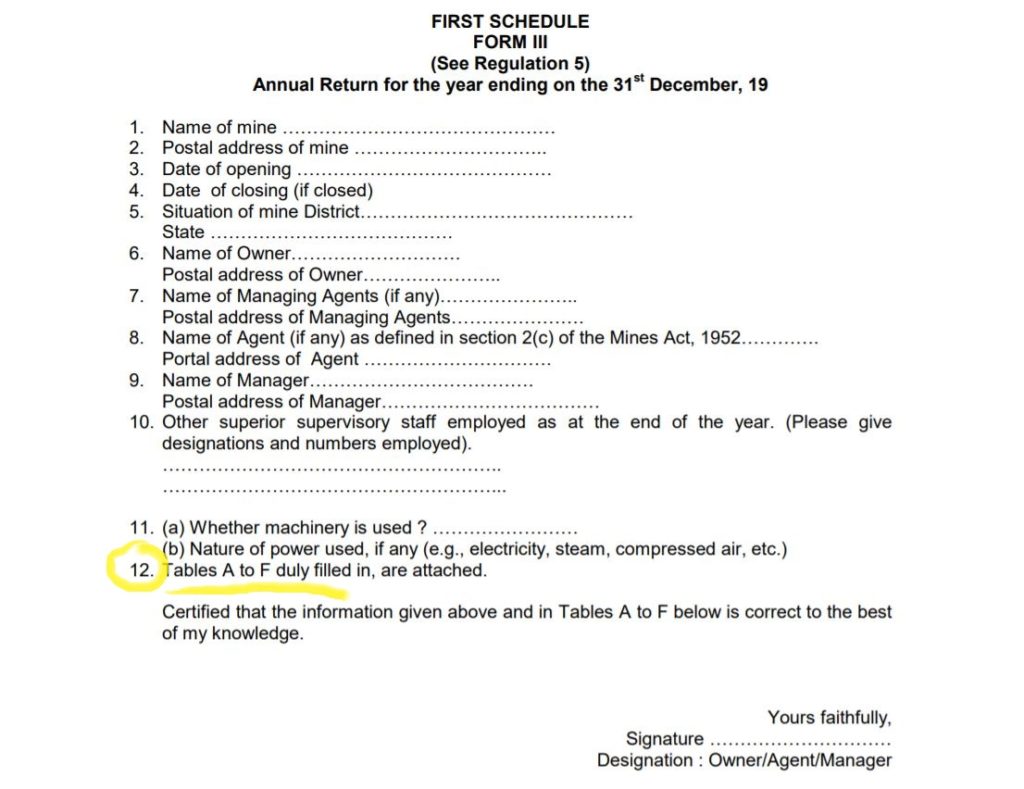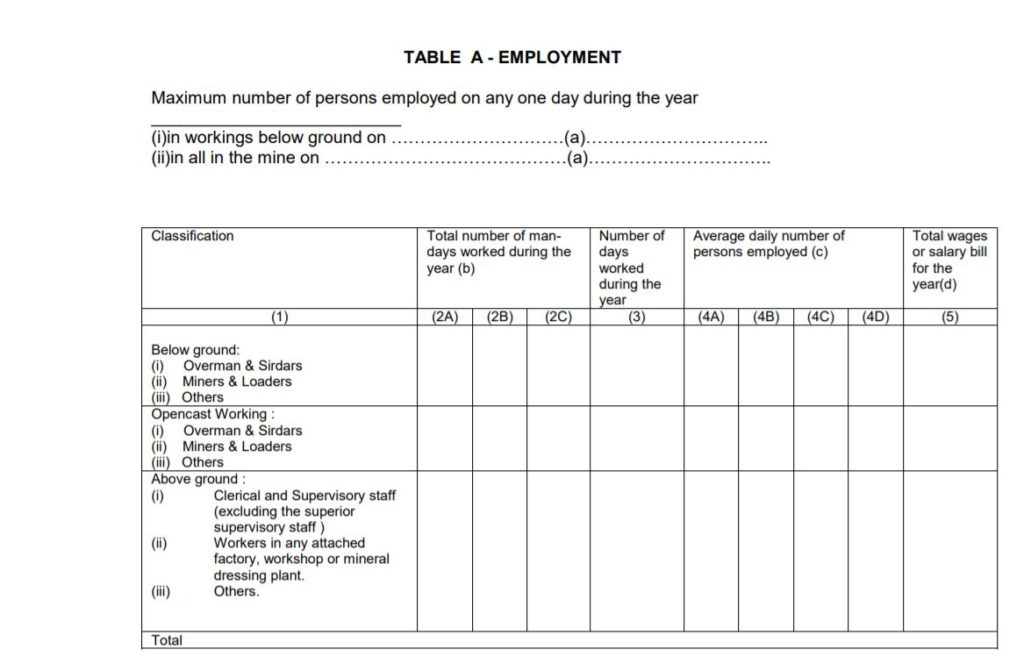Status of Underground latrines Facility in Mines of India after lapse of more than 65 years (65 वर्ष से अधिक के अंतराल के बाद भी भारत के खानों में भूमिगत शौचालय सुविधा की स्थिति)–cont..
” In this section, we tried to analyse failure of providing sanitary provision by highlighting the responsibilities of DGMS, Mines Management, Trade Unions and our Employees “…..
Role of DGMS/ Mining Inspector:
Let’s start with our Mines Rules, 1955 and it states that…..
37. Underground latrines – If in any mine more than fifty persons are employed underground at any one time, latrines shall be provided underground on a scale approved by an Inspector at convenient points near the working shafts and at entrances to the districts or sections of the mine. The latrines shall be of a type approved of in writing by an Inspector.
So, Rule is very clear that there should be underground latrine in each mine with only one condition that there should be more that 50 employees as simple as that. And also, how many no. of latrines shall be there? for this, approval from Inspector shall be taken.
नियम बहुत स्पष्ट है कि प्रत्येक खदान में भूमिगत शौचालय होना चाहिए बस केवल एक शर्त के साथ कि वहाँ 50 से अधिक कर्मचारी जो एक समय में अन्डरग्राउंड में काम कर रहें हों । और यह भी कि इसके लिए कितने शौचालय होंगे, इंस्पेक्टर से अनुमोदन लिया जाएगा।
Now, come back to our RTI reply, in which DGMS officials said that they don’t have any data regarding that…. Why they have to say like that although they shouldn’t !!
Because, from every mines, data in Form-III goes to DGMS office, each and every year, it’s in the regulation.


“It is worth mentioning here is that there is no provision of exemption in the statutory under the Mines Act, 1952 for not providing Underground Latrines. “
On the basis of above, one can easily find out that how many employees are working and whether any UG latrines require or not? Approval has been taken or not? and it is being provided and maintained by mines management or not?
Now, question arises that who’s responsibility is to check whether this provision is being followed by Mines Management or not?
Please note that:
“Directorate General of Mines Safety, DGMS in short, is the Regulatory Agency under the Ministry of labour and employment, Government of India in matters pertaining to occupational safety, health and welfare of persons employed in mines (Coal, Metalliferous and oil-mines).
So, yah of course! it’s DGMS responsibility to check whether this provision is being followed by Mines Management or not? यानि की यह जांच करना कि माइंस में शौचालय की व्यवस्था है कि नहीं? यह डीजीएमएस के कार्यक्षेत्र में आता है और ये, इस संस्था की जिम्मेदारी है।
हालांकि, जांच करने की आवश्यकता सभी खदानों में पड़ेगी भी नहीं ? क्योंकि ध्यान रहे की नियम का पालन करवाने के लिए केवल ये देखना ही प्रयाप्त हो जाएगा की 50 से अधिक कर्मचारी जो एक समय में अन्डरग्राउंड में काम कर रहें है या नहीं ? इसके लिए हरेक माइंस या खदान से मैनपावर सहित पूरी जानकारी form 3 में डाटा भरकर भेजा जाता ही है, बहुत आसानी से जाँची जा सकती है, है की नहीं ? लेकिन DGMS के पास न तो कोई डाटा है की कितनों ने अप्रूवल लिया है, न ही इस रूल को फॉलो करवाने का कोई ईरादा।
इसलिए यह कहना अतिशयोक्ति नहीं होगा कि डीजीएमएस के अधिकारियों (माइनिंग इंस्पेक्टर) के नाकामयाबी की वजह से आज 65 साल से अधिक गुजर जाने के बाद भी, आज भी हमारे माइंस में भूमिगत शौचालय की व्यवस्था नहीं हो पाई है।
It’s almost 65 years since Mines Rule 1955 enactment and still we are not having UG latrine facility! what a shame that we are unable to provide this basic facility to our employees 😐.
Role of Management:
After talking with some senior mine management, quoting above rule, I have asked that why it has not been followed? Then, after he laughed on me and said like “ऐसे ही चलता है माइंस, कही देखा है अंडरग्राउंड में लैट्रिन? सरफेस पर तो सब तोड़ ताड़ के रख देता है”
This statement may not be general but not providing this basic facility since ages leads majority of mindset in that way only. It’s simple strategy to deny the fact with some illogical things.
However, Please note that Employees are bound to follow the rules, if not, then it’s simple law and order problem in mines, isn’t?
In this regard, Rule no. 38 of Mines Rule 1955, clearly states that…
38. Sanitation-
(1) At every mine all underground working places and travelling roadways shall be kept clean from excreta. (2) All latrines and urinals in or about a mine shall be kept in a clean and sanitary condition. (3) Receptacles for night-soil shall be cleaned and disinfected at least once in every day.
(4) Proper arrangements shall be made on the surface for the disposal of night-soil and urine. Such arrangements shall comply with the requirements of any health authority or Mines Board within whose jurisdiction the mine is situated.
यानि कि, अगर कोई एम्पलाई जानबूझकर शौचालय व्यवस्था को खराब करने की कोशिश करता है तो उसे पनिशमेंट दी जा सकती है। फिर शौचालय व्यवस्था देने का मतलब समझ में नहीं आता है जबकि ये सुविधा देना मैनेजमेंट को नियम से भी और मॉरल रूप से भी जिम्मेदारी बनती है, लेकिन माइंस मैनेजमेंट पैसे बचाने के लिए और जिम्मेदारी से बचने के लिए यह सब बहाने बनाकर बचता आ रहा है, और इन सब में डीजीएमएस के इंस्पेक्टरों का इंस्पेक्शन करने के बाद भी कानूनी रूप से बाध्य न करना माइंस मैनेजमेंट के लिए सोने पर सुहागा साबित होते आया है।
नोट: अगर हमलोग गलत लिख रहें हो तो कोई ये तो बताए की कितने माइनिंग के इन्स्पेक्टर ने अपने इन्स्पेक्शन करने के बाद Form-6 में इसको वर्णित कर मैनेजमेंट को बाध्य किया है। शायद बहुत कम् लोग हों । क्युकी आरटीआई का रिप्लाई से सबकुछ साफ हो गया है की बहुत कम ही अन्डरग्राउन्ड माइंस है, जिसमे ये सुविधा दी गई है। और ये भी की ये सब महज एक दिखावा के लिए बना कर तो छोड़ नहीं दी गई है, इसका पता तो खैर कमेन्ट करके आपलोग ही बता सकते है जो उस माइंस में काम कर रहे हों ।
Role of Trade Unions and our employees:
We should not forget that these trade unions are representative of ourselves i.e. we the miners. We shall also not deny their constructive role for making this Indian Mining Industry a somewhat better one i.e. what is today now (and in comparison to older times). But their role becomes much widespread also and it is not like when some demand is fulfilled then their role is over.
In fact, these trade unions should had forced to drive the mines management and aligned the DGMS for sake of fulfillment of these provisions of sanitary system. But, these trade unions have also failed in it’s role and our employees are forced to work without availing this facility. Sometimes, we think that why employees not take stand against management and in this regard we have talked to many employees and after hearing their statements, it appears to us that they are fed up with this system and give up their hope, may be “a lone gram can’t bust the oven” अकेला चना भाड नहीं फोर सकता।
इस सब के बावजूद भी, ट्रेड यूनियन को अपने वर्कर के साथ खड़े रहना चाहिए था लेकिन उनकी सुविधा के लिए एक भी आंदोलन हमलोगों के ध्यान में नहीं आता है और कभी-कभी इन नाकामियों से ऐसा प्रतीत होता है की ये ट्रेड यूनियन, मैनेजमेंट के हाथ की कठपुतली बन गए हों, कारण जो भी हो, उन्हें अपने वर्कर के इस, बहुत ही बुनियादी सुविधा दिलवाने के लिए पुरजोर कोशिश करनी चाहिए थी ।
Now, time has came to think about this.
“World Toilet Day” (WTD) is an official United Nations international observance day on 19 November to inspire action to tackle the global sanitation crisis.
In our India too, Prime Minister is also keen on this issue. Several awareness program are being spread though his slogan “पहले शौचालय फिर देवालय” and our ministry i.e. पेयजल और स्वच्छता विभाग | DEPARTMENT OF DRINKING WATER AND SANITATION is also doing their part. On it’s website, under LIST OF PROVEN TECHNOLOGIES [SANITATION] several ideas may also be taken for implementation in mines on real and practical basis.
In last, we all are responsible for this, whether as a trade union or mines management or employee but DGMS role in this regards is more…….
अंत में, हम सभी इसके लिए जिम्मेदार हैं चाहे वो ट्रेड यूनियन हों या माइंस प्रबंधन हों या उस माइंस में काम करने वाले कर्मचारी, लेकिन इस संबंध में DGMS की भूमिका अधिक है ……
Now, BIG QUESTION arises here is that when some institution like DGMS made entirely for that purpose and it’s failing since inception, then what’s it’s purpose for such existence? why so much wastage of people’s money?
Well, That’s ours thought! what’s yours, tell us in the comment..
Further reading:
1. https://jalshakti-ddws.gov.in/sites/default/files/ZSBP_Final_book.pdf
2. https://jalshakti-ddws.gov.in/sites/default/files/Rural_Sanitation_Strategy_Report.pdf
3. https://ejalshakti.gov.in/MISC/Docs/CompendiumJuly2015.pdf#page=76
Disclaimer: This article is collected from our reliable source and published here in original i.e. word to word without any modification. If someone find it objectionable then please let us know.






